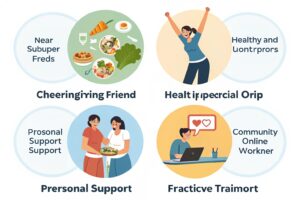Introduction
How to Build a Support System When You’re New to Losing Weight
Losing weight for the first time can feel like stepping onto a treadmill that’s already moving. The good news is you don’t have to run alone. A well‑crafted support system—whether it’s a friend, a professional, or an online community—can turn uncertainty into confidence, setbacks into learning moments, and a “new‑year‑resolution” into a sustainable lifestyle change.
In this guide we’ll walk you through the science‑backed steps to create a network that keeps you motivated, accountable, and emotionally balanced. By the end, you’ll have a concrete action plan, tools you can start using today, and a clear picture of how a strong support system can accelerate your weight‑loss journey while protecting your mental health.
Why a Support System Is a Non‑Negotiable Part of Successful Weight Loss
When you’re new to losing weight, the brain’s reward pathways are being rewired. A 2022 study in the Journal of Behavioral Medicine found that participants with a dedicated accountability partner were 34 % more likely to meet their weekly calorie goals than those who worked solo. The reason is simple: humans are social creatures, and social reinforcement triggers dopamine release that feels as rewarding as finishing a workout.
Beyond the neurochemical boost, a support system provides real‑time problem solving. Imagine you’re stuck at a holiday dinner and the temptation to overeat is high. A quick text from a friend who’s also tracking their macros can remind you of your plan, suggest a healthier swap, or simply validate the difficulty you’re feeling. This “social safety net” reduces the odds of emotional eating, which the American Psychological Association links to 20‑30 % of weight‑gain episodes in adults.
Section 2 – Identifying the Types of Support You Need

1. Emotional vs. Practical Support
Emotional support is the empathy, encouragement, and listening ear you receive when you’re feeling discouraged. Practical support, on the other hand, includes concrete actions like sharing a healthy recipe, joining a workout class together, or reviewing your food journal. Both are essential, but they serve different stages of the weight‑loss journey. Early on, emotional reinforcement helps you stay motivated; later, practical tools help you fine‑tune your habits.
2. Professional vs. Peer Support
Professional support comes from certified dietitians, personal trainers, or behavioral therapists. These experts bring evidence‑based strategies, such as the Mediterranean diet or HIIT protocols, and can tailor plans to medical conditions like pre‑diabetes. Peer support—friends, family, or online communities—offers relatability and shared experience. A hybrid approach often yields the best results: a dietitian sets the macro targets, while a Facebook group provides daily motivation and recipe swaps.
Section 3 – Building Your Core Support Circle
1. Choose an Accountability Partner Who Shares Your Vision
Select someone whose goals align with yours—whether it’s a coworker aiming to lose 10 lb or a sibling who wants to adopt a plant‑based diet. Schedule a weekly check‑in (a 15‑minute video call or a quick text recap) to discuss progress, obstacles, and next steps. Research from the University of Scranton shows that goal‑setting with a partner increases completion rates by 45 % compared with solitary attempts.
2. Enlist Professional Guidance Early
Even a single session with a registered dietitian can clarify calorie needs, portion sizes, and nutrient timing. Many health insurers now cover virtual nutrition counseling, and platforms like Nutritionix or Healthie offer affordable packages. A dietitian can also screen for hidden issues such as thyroid dysfunction, which affects 5‑10 % of adults and can sabotage weight loss if left untreated.
3. Join a Structured Community
Look for local meet‑ups (e.g., Meetup.com “Weight‑Loss Support” groups) or reputable online forums such as MyFitnessPal’s community, Reddit’s r/loseit, and Weight Watchers®. These spaces provide daily threads on meal prep, exercise ideas, and mental‑health check‑ins. A 2021 meta‑analysis in Obesity Reviews found that participants who engaged in an online weight‑loss community lost an average of 2.5 lb more over six months than those who did not.
Section 4 – Comparing Different Support Models: What Works Best for You?
1. One‑On‑One Coaching vs. Group Coaching
One‑on‑one coaching offers personalized feedback, rapid adjustments, and privacy—ideal for those with specific medical concerns or a preference for confidentiality. Group coaching, however, leverages social contagion: seeing peers succeed can inspire you to push harder. A 2020 study by the CDC reported that group‑based interventions produced a 1.8 % greater average weight loss after 12 weeks compared with individual counseling.
2. In‑Person vs. Virtual Support
In‑person meet‑ups provide tactile motivation (e.g., a shared workout class) and stronger bonding cues. Virtual support offers flexibility, especially for busy professionals or parents. Hybrid models—like a weekly Zoom workout followed by a monthly in‑person hike—combine the best of both worlds. According to a 2023 survey by Fitbit, 68 % of users who mixed virtual and in‑person activities reported higher adherence to their fitness goals.
3. Formal Programs vs. DIY Networks
Formal programs (e.g., Weight Watchers®, Noom, or Jenny Craig) come with structured curricula, tracking tools, and professional oversight. DIY networks rely on self‑curated resources, which can be cost‑effective but may lack accountability. If you thrive on clear guidelines and enjoy gamified progress tracking, a formal program may be worth the investment. Conversely, if you’re comfortable researching nutrition science and setting your own milestones, a DIY approach can work well—just be sure to anchor it with at least one professional check‑in per month.
Section 5 – Practical Tools and Step‑by‑Step Guide to Activate Your Support System
1. Set Up a Shared Tracking System
Choose a platform that both you and your accountability partner can access—Google Sheets, MyFitnessPal, or Fitbit’s shared dashboard. Create columns for daily calories, water intake, mood rating, and exercise minutes. Seeing trends side‑by‑side makes it easier to spot patterns (e.g., higher stress correlating with snack spikes) and adjust accordingly.
2. Schedule “Support Rituals”
-
- Monday Meal‑Prep Call (15 min): Swap recipes, prep grocery lists, and set macro targets for the week.
-
- Wednesday Workout Buddy Session (30 min): Either a live‑streamed HIIT class or a joint walk in the park.
-
- Friday Reflection Text (5 min): Share wins, challenges, and a motivational quote.
Consistency turns these rituals into habit loops, reinforcing the cue‑routine‑reward cycle described in Charles Duhigg’s The Power of Habit.
- Friday Reflection Text (5 min): Share wins, challenges, and a motivational quote.
3. Leverage Technology for Real‑Time Encouragement
Install habit‑stacking apps like Habitica (gamifies tasks) or Streaks (tracks consecutive days). Enable push notifications that remind you to log meals or stand up every hour. Some apps also allow you to invite friends who can “cheer” you on, providing instant dopamine hits when you hit a milestone.
Section 6 – Overcoming Common Challenges and Maintaining Momentum
1. Dealing with Unsupportive Environments
If family members frequently bring high‑calorie foods to the table, communicate your goals clearly and suggest healthier alternatives. Offer to cook a dish you love that aligns with your plan—this demonstrates that you’re not asking for sacrifice, but for collaboration. When direct conversation isn’t possible, use environmental design: keep a stocked fridge of pre‑cut veggies, portioned nuts, and low‑sugar Greek yogurt to reduce temptation.
2. Managing “Support Burnout”
Even the most enthusiastic accountability partner can experience fatigue. To prevent burnout, rotate responsibilities—let your friend lead the Wednesday workout one week, and you lead the Monday meal‑prep the next. Celebrate small victories with non‑food rewards (e.g., a new workout shirt or a massage). Research from the International Journal of Behavioral Nutrition and Physical Activity indicates that varied support roles increase long‑term adherence by 22 %.
3. Re‑Evaluating and Scaling Your Network
As you progress, your needs will evolve. After the first three months, schedule a quarterly review with your dietitian to adjust calorie targets and discuss any plateaus. Consider expanding your community by joining a specialty group—for example, a “post‑partum weight‑loss” forum if you’re a new parent, or a “senior fitness” class if you’re over 60. Tailoring your support to life stages keeps the system relevant and effective.
Conclusion & Call to Action
Building a support system when you’re new to losing weight isn’t a one‑size‑fits‑all checklist; it’s a dynamic, evidence‑based process that blends emotional encouragement, professional expertise, and practical tools. By deliberately selecting accountability partners, leveraging technology, and establishing regular rituals, you create a resilient network that propels you past the inevitable hurdles of weight loss.
Ready to start? Begin today by reaching out to one potential accountability partner and setting up a shared tracking sheet. Then, schedule a 15‑minute virtual consult with a registered dietitian to solidify your nutrition plan.
If you found this guide helpful, share it with friends who are also on a weight‑loss journey, leave a comment with your own support‑system success stories, and explore our related articles on “Top 10 Low‑Calorie Snacks for Busy Professionals” and “How to Use Mindful Eating to Beat Emotional Cravings.” Together, we can turn the path to a healthier you into a community‑driven adventure.
Keywords (LSI): weight‑loss support, accountability partner, nutrition coaching, fitness community, habit formation, sustainable weight loss, emotional support, online forums, dietitian, personal trainer, behavior change, healthy lifestyle, calorie tracking, peer motivation.



